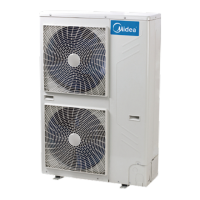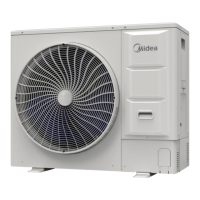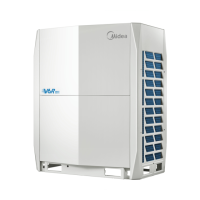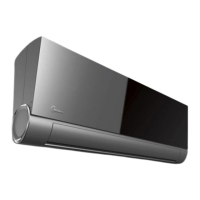R410A All DC Inverter V4+S Series 60Hz MCAC-VTSM-2015-09
112 Installation
2. Supporting, hanging and mounting brackets cannot be installed at air vent, valves, checking door and
automatically controlled device, and distance to air opening or plugged tube shall not be less than
0.66ft.(200mm).
3. Hanging brackets should not be hung above flanges.
4. Thickness of flange gasket should be 0.12-0.2”(3-5mm). Gasket should set flat against flange and inserting
to pipe is not allowed. Set up fixed points in suitable areas for hanging pipe to prevent vibration.
5. Vertical splice seam of duct should be stagger. Make sure there is no vertical seam at the bottom of duct
installed horizontally. As for the installation of flexible short duct, keep proper tightness and no distortion.
6. All metal parts (including supporting, hanging and mounting brackets) in piping system should be given
anti-corrosion treatment.
6.4 Installation of Assembly
1. Air flow regulators should be installed in easily accessible areas..
2. The air vent should be installed firmly and duct should be connected tightly. Duct construction should blend
with building design. The appearance should be smooth and level, and regulation is flexible.
3. If air vent is installed horizontally, level deviation should be no more than 3/1000. If air vent is installed
vertically, deviation from perpendicular should be no more than 2/1000.
4. Air vent in same room should be installed at the same height, and put in order.
7. Heat Insulation Engineering
The insulation of refrigerating equipment and piping follows general insulation methods. Insulating shall be
carried out in a manner best suited for selected insulation material.
7.1 Insulation of Refrigerant Piping
7.1.1 Operational procedure of refrigerant piping insulation
Construction of refrigerant pipe → insulation (excluding joints) →air tightness test → joint insulation
Joints: Insulation of welded joints or flanges should be carried out after air tightness is confirmed.
7.1.2 Purpose of refrigerant piping insulation
1. During operation, temperature of gas pipe and liquid pipe will be heated or cooled excessively. Therefore, is
necessary to insulate in order to guarantee unit performance and compressor life span.
2. Gas pipe temperature is very low during cooling. If insulation is insufficient, condensation will form and
cause leakage.
3. Temperature of gas pipe is very high (generally 122-212°F(50-100°C) during heating. Insulation serves as a
necessary protection from burning..
7.1.3 Selection of insulation materials for refrigerant piping
Adopt closed-cell foam insulation materials with a B1 fire resistant rating and over 248°F(120°C) of constant
burning performance.
7.1.4 Thickness of insulation layer
1. When outer diameter of copper pipe (d) is less than or equal to 1/2”(12.7mm), the thickness of insulation
layer (δ) shall be above 19/32”(15mm).
When outer diameter of copper pipe (d) is more than or equal to 5/8”(15.88mm), the thickness of insulation
layer (δ) shall be above 25/32“(20mm).
2. In hot and wet environments, the above recommended value shall be doubled.
Note: The outdoor piping shall be protected by metal casing to protect against sunlight, rain, air erosion and
any other potential causes of damage.
7.1.5 Installation and main points of insulation construction
1. Example of incorrect insulation: Gas and liquid piping are insulated together reducing air conditioner
efficiency and effectiveness.
2. Example of correct installation:
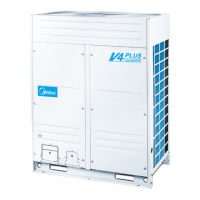
